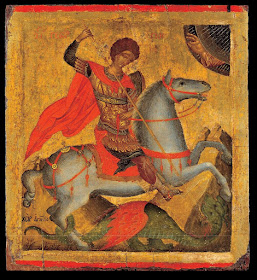Interestingly, the same division of the year exists in Serbian calendar, where the light (hot) part starts on St George's day and ends on St Mitar's day and the dark (cold) part starts on St Mitar's day and ends on St George's day...I talked about this in my post "Two Crosses".
St George's day is celebrated on the 23rd of April, just few days before the beginning of summer (6th of May, mid point between Spring Equinox and Summer Solstice)...This day is said to commemorate the day of execution of St George. Icons made for this day depict St George on a horse with a spear killing the Dragon...
In Serbia, there is another St George's day which is celebrated on the 3rd of November. Just before the beginning of winter (5th of November, mid point between Autumn Equinox and Winter Solstice). This day is said to commemorate the consecration of the church in Lydda, built by Constantine the Great, which housed the relics of the Saint George...Icons made for this day depict St George standing with a spear...
It is interesting that these two St George's days mark the beginning and the end of the white (hot) part of the year dominated by the sun...When we know that St George is Christianised Jarilo, Slavic sun god...
In Slavic mythology snake is the symbol of the sun, sun's heat. Snakes come to the surface during white, hot part of the year. During the summer, the hottest part of the year, sun's heat becomes destructive. This is burning sun is symbolically represented as a dragon breathing fire.
As I said I always found it very funny that the Sun God Jarilo, whose name means Brightly Burning, Raging one, Who is the Dragon, was replaced by St George, Dragon killer. And that St George kills the Dragon on the day which is in Gaelic calendar known as Bealtaine (The day of the brightly burning fire). The day when people light up bonfires to mark the beginning of Summer, the hottest part of the year. The day when sun snake turns into a sun Dragon.
St George also kills himself (Jarilo, Dragon) on the day when he was apparently executed according to Christian cannon...
All very strange and coincidental...
In the past in Serbia, the St George's day marking the beginning of summer, was the day by which the flocks were brought up to the highland pastures. And the St George's day, marking the beginning of winter, was the day by which the flocks were brought down from the highland pastures...
Which is why St George is the patron saint of shepherds...I talked about many interesting Serbian rituals related to sheep performed on the St George's day marking the beginning of summer in my post "Aries must die".
By the way, there is another Sun god which is also a Shepherd god...
Apollo...
Apollo who is Greek Jarilo...
Just in case people still wonder whether Apollo was originally Shepherd God who acquired attributes of a Sun god. It was probably the opposite...
As I said I always found it very funny that the Sun God Jarilo, whose name means Brightly Burning, Raging one, Who is the Dragon, was replaced by St George, Dragon killer. And that St George kills the Dragon on the day which is in Gaelic calendar known as Bealtaine (The day of the brightly burning fire). The day when people light up bonfires to mark the beginning of Summer, the hottest part of the year. The day when sun snake turns into a sun Dragon.
St George also kills himself (Jarilo, Dragon) on the day when he was apparently executed according to Christian cannon...
All very strange and coincidental...
In the past in Serbia, the St George's day marking the beginning of summer, was the day by which the flocks were brought up to the highland pastures. And the St George's day, marking the beginning of winter, was the day by which the flocks were brought down from the highland pastures...
Which is why St George is the patron saint of shepherds...I talked about many interesting Serbian rituals related to sheep performed on the St George's day marking the beginning of summer in my post "Aries must die".
By the way, there is another Sun god which is also a Shepherd god...
Apollo...
Apollo who is Greek Jarilo...
Just in case people still wonder whether Apollo was originally Shepherd God who acquired attributes of a Sun god. It was probably the opposite...







I have a copy of such a "modern" icon from a church in Bosnia, in which Saint George looks like Alexander the Great ...
ReplyDeleteAnother ancient middle eastern sun god is Shamas (or Shamosh) aka Thamas (Thomas) aka Seamus (James). In a book called The British Edda, the author Laurence Austin Waddell (CB, CIE, F.L.S., L.L.D, M.Ch., I.M.S. RAI, F.R.A.S as per wikipedia) states that St. George is one and the same as the biblical Adam and that St. George slew the dragon (Eve's mother, matriarchal ruler ) in Karkamis (Car Shamash or Gymis, Car signifying, fortification, from the Udmert word for nest), married Eve and founded the first empire there. His descendants through his son Cain (John, Sean, Zion) founded the subsequent ancient middle east empires. He also identifies St George with St Andrew, Odin and Thor both, and King Arthur (Herr Thor) via a close reading of the Edda, the Vedas (both having the same source) and ancient Sumarian inscriptions on cylinder seals depicting scenes of these legendary people. At the time of her death I learned that British Queen Elisebeths' genealogy goes back to both Odin and Adam. St George is the patron saint of farmers and in Britain all the planting is to be done before St Georges Day.
ReplyDelete